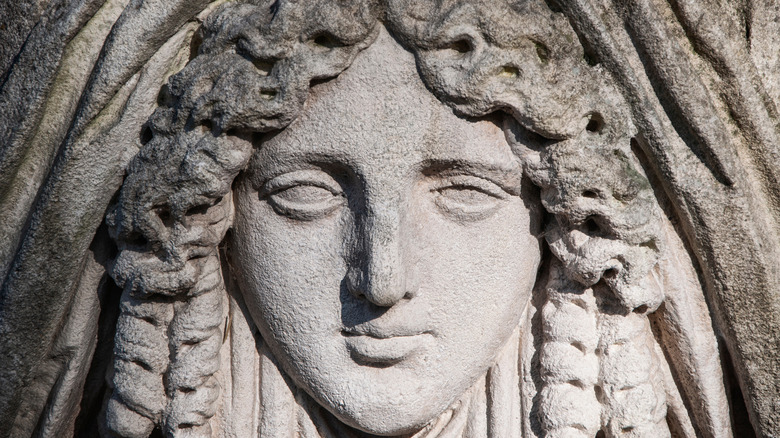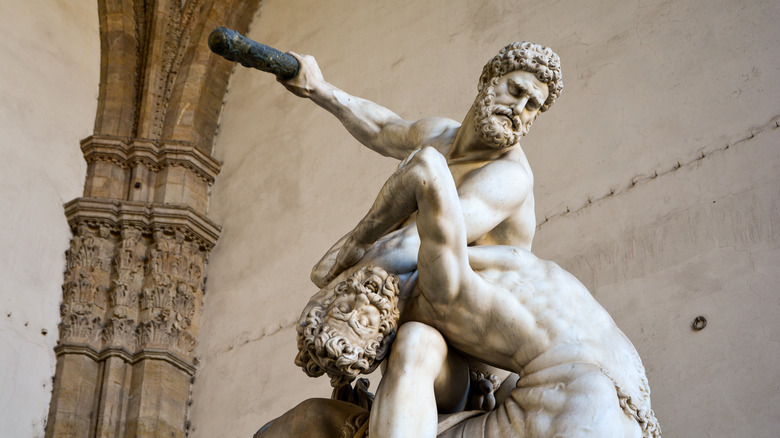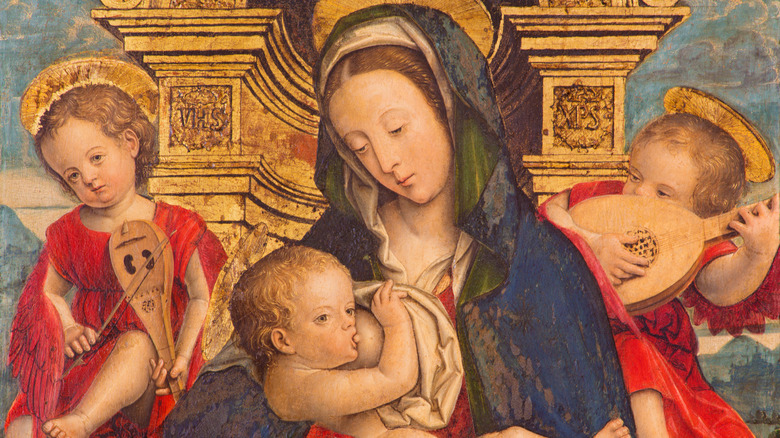The Mythical Nursing Mother Story That Named The Milky Way
Sometimes it's hard to place ourselves in the position of ancient peoples. Before folks could instantly jump online and find out that our Milky Way galaxy contains between 100 and 400 billion stars (via Universe Today), what explanations would people have had for those shining specks of light in the sky? Was there some kind of dark bedsheet tossed over Earth and poked through with holes by a goddess' needle? If so, then everything beyond the bedsheet is pure light. Or maybe the stars are really hot fires far, far away. Spherical fires burning and spinning in a vast, black emptiness that ... oh hang on, that's actually pretty close to the truth.
Out of all the possible, ancient explanations for the creation and appearance of our galaxy as seen from Earth, many Western and European traditions commonly settle on one image: milk. In Germany, the Milky Way is called "Milchstraße," and in Norway "melkeveien," which both mean "milk road," as Today I Found Out explains. To be sure, on a clear night away from the haze of city lights, the Milky Way does indeed look like a kind of road. Go back further and we've got "Via Lactea" in Latin ("road of milk"), and further, "galaxias kyklos" in Greek ("milky circle").
At this point in Ancient Greece, we find the origins of our moniker, "The Milky Way." Like all milk, it comes from a mother. And in this case, it comes from the queen of the gods herself, Hera.
Shooting breastmilk across the sky
The story of Hera and the Milky Way's name isn't some cutesy, heartwarming motherhood tale. Folks even vaguely familiar with Greek myth might remember that Zeus, thunder-hurling king of the gods, was something of a cad. He was a serial sire-er of out-of-godlock children: Athena, Apollo, Artemis, Hermes, Dionysus, Hercules, Perseus, Helen, Minos, and even the Three Fates and Nine Muses themselves, as World History Encyclopedia reminds us. Bear in mind that's the shortlist. Oh, and did we mention that Hera, Zeus' wife, was actually Zeus' sister? Not to say that lets him off the hook, but it does cast things in a different light.
Herakles ("Hercules" to the Romans), the big, strong demigod dude who went on twelve trials — The Labors of Herakles — is one of Zeus' more famous illegitimate children. Herakles, however, didn't set off on his trials because he had something to prove, but because Hera wanted him sent on a death mission. Hera despised Herakles because he was a constant reminder of Zeus' infidelity. As Theoi says, this is why Herakles was raised by his mortal mother, Alcmene, and her husband, Amphitryon. Hera tried to kill Herakles when he was a baby by putting some snakes in his crib, but strong baby Herakles just crushed the snakes. Before that, Zeus had given Herakles to Hera to nurse. Hera, though, pulled the infant away from her breast, and her breastmilk shot across the sky. Bam: instant Milky Way.
A complicated family tree
We admit that it's a bit disconcerting to imagine that the stars of our beautiful, vast, 100,000-light-year-wide galaxy were created from the infanticidal rage and projectile breastmilk of a spurned deity. Maybe that's how deep Hera's wrath ran, and how much of a cautionary tale the Greeks wanted to impart. Or maybe it's not a story about scorned motherhood at all, but rather the power of Hera's life-giving milk. Her body lit up the entire night sky instead of feeding the might of one, single offspring. Maybe this is why Herakles' name — if you notice Hera's name embedded in it — literally means "glory of Hera," as Behind the Name cites.
But the drama of Hera, Herakles, and the gods' extended family tree continues far beyond this one vignette. Hera tried to ruin Herakles' life again and again. Before he was born, Hera sent the goddess of childbirth, Eileithyia, to stymie Herakles' birth by sitting cross-legged at the door to his birthing room (maybe symbolizing a garbled position in the birth canal, e.g.), via Theoi. When Herakles grew up, Hera drove him mad and he killed his own wife and children. This is when he was sent on his 12 labors, in part to atone, as History says. And later on, Hera drove Herakles mad again and he chucked his best friend Iphitus off a city wall, as Classical Wisdom explains. Such tales definitely sound like warnings about the psychological destructiveness of fractured families.
Other mythical milk mentions
The tale of the Hera, Herakles, and the birth of the Milky Way isn't the only mention of mythical milk in story and history — not by far. It should make sense that mother's milk is typically associated with life, abundance, sustenance, that kind of thing. This is true even in Hera's case; her milk gave life to the darkness of night itself.
In other stories, as Interesting Literature points out, we've got Mary the mother of Jesus. Have you ever wondered why so many medieval paintings of Mary depict her breastfeeding Jesus? "Nursing Mary" — aka "Maria Lactans," "Virgo Lactans," and "Madonna Lactans" — was practically an entire sub-genre of art for hundreds of years. It wasn't weird at all, even for what we might think of as overly modest, ancient Christians. It was only during the Protestant Reformation that Maria Lactans artwork got the old taboo treatment, as Washington Post describes. Afterward, from 1750 on, Jesus was primarily depicted as a suffering, tormented, and bloodied guy dying on a cross.
There are plenty of other examples of mythical milk, as well. In Ancient Egypt the goddess Isis was often shown suckling the god Osiris, to represent his rebirth. Rituals honoring the god Mithras, a Zoroastrian deity, involved drinking milk and honey, as did rituals to honor the Greek god Attis. Milk and honey, of course, were also used to represent the Jewish "promised land" in the book of Exodus in the Bible. On and on it goes.
Alternative Milky Way monikers
Languages Trainers describes alternative takes on both the name and origins of the night sky from various cultures. In Finnish myth – which is its own, separate thing aside from any other global mythology — the stars are little fragments of an eggshell laid by a great sky bird. When the egg hatched its shell created a path of stars in the sky — "Lintukoto," or "home of the birds" — that birds use to navigate during migration periods. This great sky bird was born from the goddess of air, Ilmatar, who came down to Earth one day because she got bored, as Study explains. In Sweden the Milky Way is called "vintergatan," and in Iceland "vetrarbrautin," both of which basically mean "Winter Way," as it's commonly thought that stars are more visible in winter months.
Meanwhile, the Andes-dwelling Incas of Peru believed the Milky Way was a pathway to the divine and an extension of the river Vilcanota. The dark patches in the sky were the homes the llama, snake, and toad gods. The Apache likewise believed that the Milky Way was the path to the afterworld that souls traveled with the goddess of death, Yolkai Nalin. The Mayans believed the Milky Way was a manifestation of the World Tree (similar to the Norse Yggdrasil) that carried the maize (corn) god to the origins of creation. In countries like China and Japan, the Milky Way is called the "Silver Way."
The renewal of the cycle of life
Going back to the Hera, Herakles, and lost mother's milk story: Is there anything else to the tale? The Ancient Greeks didn't know that stars have a life cycle all their own. No matter how eternal they seem to the blip of human life, stars are born, live, burn out, and wind up in several late-life states: shrunken white dwarf, expanding red giant that explodes and collapses into a neutron star, or expanding red giant that explodes and collapses into a black hole (as sites like Astronomy and the National Schools' Observatory describe).
In about 5 billion years, our own sun will expand into a red giant and consume Earth, as Astronomy explains. But long before then, our entire Milky Way galaxy will start to merge with our neighbor, the Andromeda galaxy. In about 2 billion years, the Andromeda Galaxy will start getting larger in the night sky. For a full 5 billion years, we'll get all sorts of crazy light shows and warped galactic shapes filling up the night sky. At this point, the "Milky Way" won't look at all like its current path of white dots. In 7 billion years, the Milky Way and Andromeda will be finally fused into "Milkdromeda," as Kottke depicts.
So what would the ancient Greeks make of this? Perhaps it changes nothing. Hera, after all, created life after denying life to Herakles. So too will the destruction of one set of stars create another.





